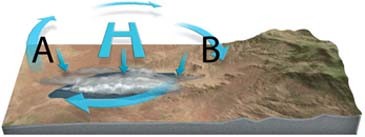How many semipermanent highs and lows typically exist in the northern hemisphere in January?
A. 10
B. 7
C. 5
D. 4
Answer: B
Environmental & Atmospheric Sciences
You might also like to view...
All of the following factors would contribute to water to sinking at the poles except
A) lack of atmospheric water vapor. B) absence of clouds. C) formation of brine. D) melting ice.
Environmental & Atmospheric Sciences
In the anticyclone pictured here, the winds at "A" are from the ________ bringing ________ temperatures.
A. north; cooler B. north; warmer C. south; cooler D. south; warmer
Environmental & Atmospheric Sciences
Where does ground amplification of seismic waves often take place?
A. In mountainous bedrock areas B. On a transform fault C. In sedimentary basins D. On a mid-ocean ridge
Environmental & Atmospheric Sciences
Nutrient flow in an ecosystem is ________
A) bi-directional B) cyclical C) semi-conservative D) top down E) unidirectional
Environmental & Atmospheric Sciences